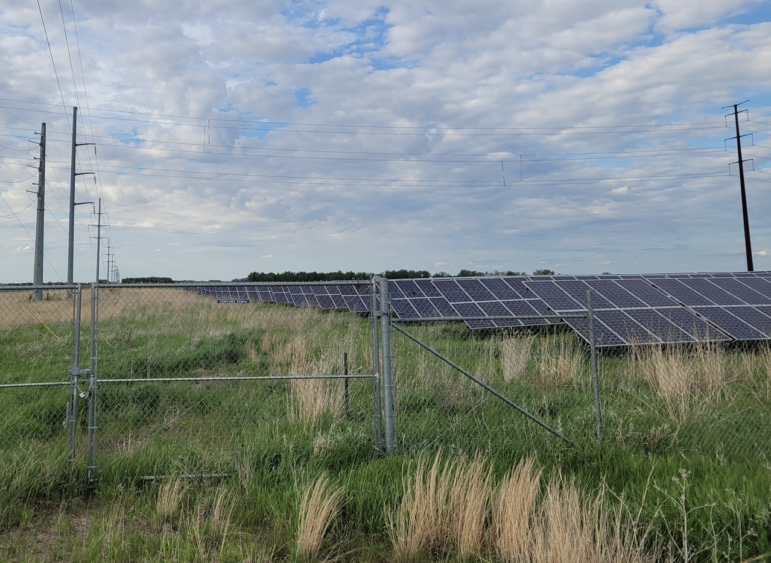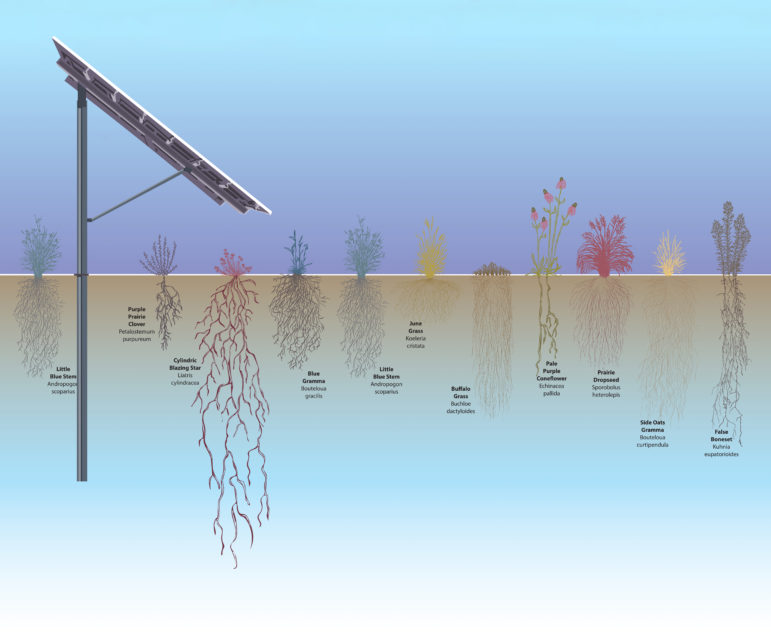
Developer/owner: NextEra Energy Resources
Vegetation: Prairie Restorations, Inc.
Location: Lyon County, Minnesota
Size: 62 MW (355 acres, scorecard)
Constructed in 2016, the 62 MW Marshall Solar Energy Project is located on 355 acres of agricultural land in Lyon County, three miles east of Marshall, Minnesota. Partly in response to several visual renderings of the project showing acres of closely mowed suburban-style turfgrass, the proposed project received little support and drew active pushback from residents who were concerned about the loss of prime farmland and how it could affect their property values.
A group of four neighbors hired an attorney to present their case to state regulators. Due to the project’s location on prime agricultural soils, the state’s Administrative Law Judges recommended that any site permit include an Agricultural Impact Mitigation Plan and a Vegetation Management Plan that required establishment and maintenance of ground cover that is beneficial to pollinators and other wildlife. Marshall Solar worked with native landscape specialists and staff from the departments of Agriculture and Natural Resources to craft the Agricultural Impact Mitigation and Vegetation Management plans. Following a delay of several months while the project’s use of prime farmland was studied, the Minnesota Public Utilities Commission determined that the project complied with state rules to protect prime agricultural land and voted unanimously to approve the plan.
“A native prairie can be aesthetically attractive to a lot of people, but there might be some people that would go, ‘Wow, that should be a cornfield,’” said Ron Bowen, former CEO of Prairie Restorations. “I would say, look, a 50-acre field of wildflowers with some monarch butterflies flying around is more attractive than a soybean field or a cornfield for a lot of reasons.”

Unlike shallow-rooted turf grass, the vegetation at the Marshall Solar site will prevent erosion, provide habitat for pollinators, and improve the quality of the soil for farming after decommissioning. The upfront costs can be similar, but long-term management and maintenance costs are typically higher for turf grass, which needs to be mowed more frequently. For Marshall Solar, NextEra seeded the entire project with a grass mixture, then supplemented the rows and open area (227 acres) with a variety of flowering plants. Seed producers reviewing the plans estimate NextEra’s seed mix cost around $750 per acre—a difference of less than 0.1% of the total project budget compared to an all-grass mix.

During its first four years of growth, low-growing meadow at sites like Marshall Solar should only need three to five visits for mowing and de-weeding, noted Colleen Hollinger, who worked for Prairie Restorations when the project was underway. However, after year four, many sites are self-sustaining for the remaining life of the array, requiring zero to 1.5 visits on average.
Comparisons of turf-type grass versus regionally appropriate, diverse meadows have been published by Argonne National Laboratory, in a study by Mahan Rykiel Associates for Xerces Society, and published in APWA Reporter. The Mahan Rykiel report found the life-time cost of turf to be five times greater than the costs for low-growing meadows.
In partnership with the University of Minnesota, Argonne National Lab did an extensive study to model and quantify the benefits of native vegetation, compared to turf, and row-crops. The results included +65% carbon storage potential, +95% sediment retention, +19% water retention, and three-fold increase in abundance of beneficial insects for crop pollination and pest control.

